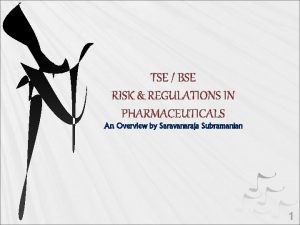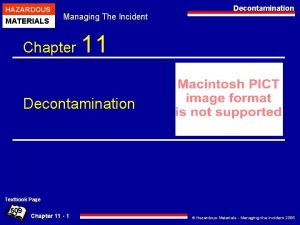Analysis of Nutrient Loading and Coliform Contamination of

- Slides: 1

Analysis of Nutrient Loading and Coliform Contamination of the Sauk River (St. Cloud, MN) Jacob Galzki & Mitch Bender Abstract E. coli Phosphate 1. 1) 2. 1) mg P/L Rain event CFU/100 m. L The degradation of water quality due to anthropogenic activity adversely affects both recreational and natural values of waterways worldwide. Agriculture and urban sprawl are two large contributors to water quality degradation. Fertilizers are often used in excess and animal wastes are often not managed properly. Both fertilizers and animal wastes contain nutrients which can be carried to nearby waterways during periods of rainfall. This can lead to eutrophication, which may cause a loss of biodiversity, fish kills, and ultimately a loss of the natural beauty of the affected body of water. Animal wastes may also contain harmful bacteria, such as E. coli, which is a direct threat to human health. From September 2005 through October 2006, a study was conducted to examine the levels of nutrients and coliform bacteria in the Sauk River near St. Cloud, MN. When weather permitted, grab samples were taken from the Sauk River biweekly and after significant rain events (>1. 25 cm). The samples were analyzed in the laboratory for nitrate, phosphate, and ammonia (three nutrients commonly found in agricultural fertilizers and animal wastes). The samples were also analyzed for coliform contamination. Nutrient loading was calculated at 58 Mg per year for PO 4 -P; 1, 433 Mg per year for NO 3 -N; and 112 Mg per year for NH 3 -N. E. coli levels were measured over the EPA recreational standard of 126 CFU/100 m. L during 8 of the 18 sampling dates. The highest level was measured at 690 CFU/100 m. L and the average was 146 CFU/100 m. L. St. Cloud State University rd a nd ta S ter a l. W a ion t a cre A EP Re 6 12 Table 1. Temperature, p. H, conductivity, suspended solids, and total solids for each sample date averaged from three grab samples. L m 00 /1 U F C Sample Date Ammonia 2. 2) Discussion • Nutrient loading was calculated at 58 Mg per year for PO 4 -P; 1, 433 Mg per year for NO 3 -N; and 112 Mg per year for NH 3 -N. Introduction mg N/L Sample Date Total coliform • E. coli levels were measured over the EPA recreational standard of 126 CFU/100 m. L during 8 of the 18 sampling dates. The highest level was measured at 690 CFU/100 m. L and the average was 146 CFU/100 m. L. 1. 2) • 7 of the 9 rain events triggered E. coli levels above EPA recreational standards. Rain event • The highest total coliform level was measured at 15, 570 CFU/100 m. L and the average was 5374 CFU/100 m. L. Sample Date CFU/100 m. L Anthropogenic sources of nutrients can influence runoff and contribute to nutrient loading of nearby waterways. Increases of these nutrients have been associated with water quality issues, such as eutrophication. When an excess amount of nutrients enter a body of water, growth of aquatic vegetation is accelerated. This vegetation cannot sustain itself and eventually dies. This process results in lower dissolved oxygen levels in the body of water and can threaten fish populations and other aquatic life. When left unchecked, eutrophication can also lead to surface scum, pest infestations, and foul odors which severely impairs the recreational value of a body of water. Coliform bacteria that are associated with agricultural practices, like E. coli, also enter surface runoff and eventually nearby waterways. These coliform bacteria are found in the intestinal tracts of warm blooded creatures and are spread through feces. If ingested they can cause symptoms in humans ranging from abdominal cramping and diarrhea to kidney failure, paralysis, and, in rare cases, death. Most strains of E. coli are harmless, but their presence in waterways should act as a red flag to health officials (Davidson, 2005). Nitrate 2. 3) Conclusion mg N/L • The high levels of coliform bacteria found in the Sauk River have the potential to cause health risks to individuals using the river for recreational purposes. Research Project Objectives • Spikes in coliform bacteria levels appear to correlate with rain events, leading to the conclusion that surface runoff is contributing these bacteria to the river. • Determine the current nutrient and coliform bacteria levels in the Sauk River near St. Cloud, MN. • These findings have triggered future research that will investigate E. coli hot spots along the entire river in effort to determine the locations of possible problem areas. • Monitor changes in the water quality over time and in relationship with rain events (> 1. 25 cm). • Determine the need for future investigation concerning agricultural and urban development effects on the nutrient and coliform bacteria levels in the Sauk River. Sample Date Fig. 1. 1 and 1. 2 E. coli and total colifom contamination measured in colony forming unit (CFU) counts per 100 m. L sample (error bars represent standard deviation). Methods and Analysis Fig. 2. 1, 2. 2, and 2. 3 Nutrient concentration measured in milligrams per liter: phosphate, ammonia, and nitrate respectively (error bars represent standard deviation). a) 3) b) • Grab samples were taken in replicate from the Sauk River biweekly and after significant rainfall events (>1. 25 cm). • The location of sample collection was near the Sauk River’s confluence with the Mississippi River near St. Cloud, MN. • Ortho-phosphate concentration was determined using an ascorbic acid reduction spectrophotometric procedure (Clesceri et al. , 1989). using a • Clesceri, L. S. , Greenberg, A. E. , & Trussell, R. R, (editors). 1989. Standard Methods for the Examination of Water and Wastewater, 17 th ed. DHA-AWWA-WDCK. Washington D. C. Sampling Site St. Cloud Photo Credit: Matt Lenz • Crumpton, W. G. , Isenhart, T. M. , & Mitchell, P. D. 1992. Nitrate and organic N analyses with second derivative spectroscopy. Limnology and Oceanography. 37: 907 -913. Photo Credit: Jacob Galzki c) d) m • Using standard methods for the examination of water and wastewater, the samples were analyzed for p. H, conductivity, suspended solids, and total solids (Clesceri et al. , 1989). • Davidson, O. G. 2005. Hung Out to Dry: post Katrina floodwaters are dirty, but so are other U. S. waterways. Grist Magazine. 11 Oct 2005. • EPA (2003). Total Coliforms and E. Coli Membrane Filtration Method. Retrieved 18 January 2006 from: http: //www. epa. gov/safewater/disinfection/lt 2/pdfs/guide_lt 2 _mlmanual_appendix-o. pdf. salicylate • Total coliform and E. coli levels were determined using an EPA approved -Coli. Blue 24 membrane filtration method (EPA, 2003). Dr. Mitch Bender, Research Advisor Dr. Charles Rose, Nitrate Analysis Assistance References • Nitrate concentration was determined using a second derivative UV/visable spectrophotometric procedure (Crumpton et al. , 1992). • Ammonia concentration was also determined spectrophotometric method (Clesceri et al. , 1989). Acknowledgements & References • MN DNR Data Deli. Map Data. Retrieved 2 October 2006 from: http: //deli. dnr. state. mn. us/ Cartography by Jacob Galzki Data Source: MN DNR Data Deli Fig. 3 Map displaying the confluence of the Sauk and Mississippi Rivers, as well as the watershed the Sauk River drains. Photo Credit: Mitch Bender Photo Credit: Vanessa Bradseth Photo a) obtaining water samples; Photo b) incubating bacterial plates; Photo c) colony development after 24 hour incubation; Photo d) colony analysis • MPCA (2005). Specific Standards of Quality and Purity for Class 2 Waters of the State; Aquatic Life and Recreation. Retrieved 19 January 2006 from: http: //www. revisor. leg. state. mn. us /arule/7050/0222. html.

